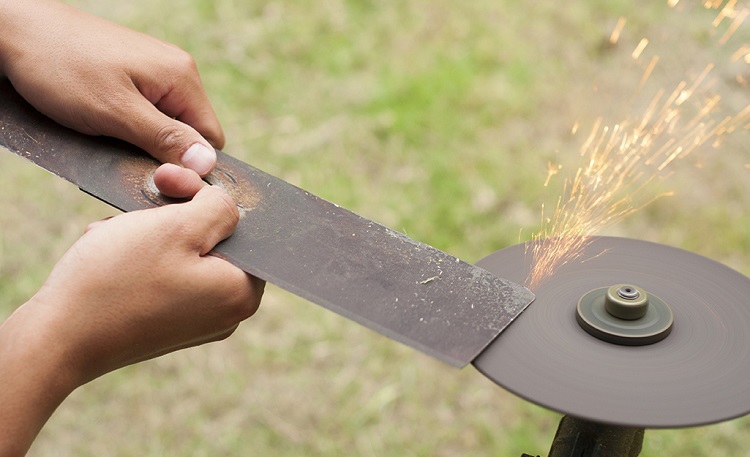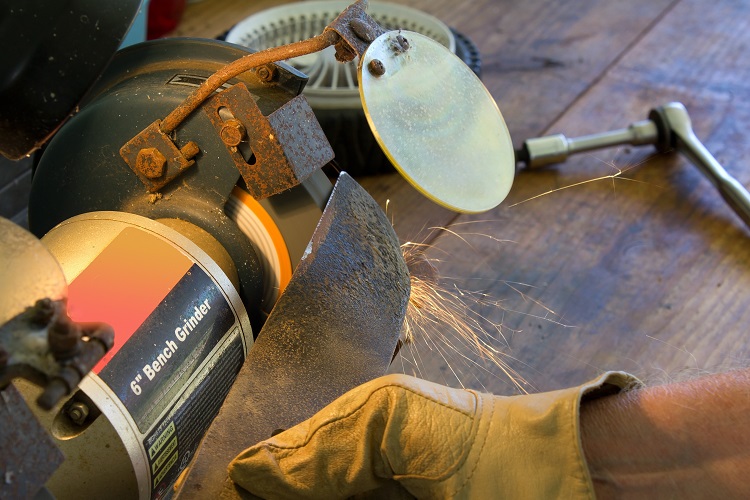
A Simple Guide on How to Sharpen Lawn Mower Blades
If there’s one piece of gardening equipment that earns its keep, it has to be the lawnmower.
As the most widely used gardening tool then, it makes sense that the blades of our mowers can get a little dull and need a good sharpening.
How do you sharpen lawn mower blades? There are a few methods for sharpening mower blades including by hand with a file, or using an angle grinder or drill-powered blade sharpener. The process should take less than half an hour and the sharpness will last all year, so it’s worth the time and effort. A lawnmower with sharp blades will be much more efficient at cutting grass and gentle on your lawn as well, so it’s a no-brainer.
Learning how to sharpen lawn mower blades is the best thing you can do for your lawn and mower, so check out this guide on how to get it done the easy way.
Why Do Lawn Mower Blades Go Dull?

As soft as most grass blades usually are, your lawn mower won’t stay sharp cutting them forever.
When you think about the additional effort it goes through as it hits twigs and rocks, plus the regular cutting of the grass, you’ll see why sharpening it is important.
If it seems that your lawnmower is still doing a good job of cutting the grass but it’s been more than a year since you sharpened them, don’t be fooled.
Mowing the lawn with a dull mower blade can do serious damage to your grass, leave it looking uneven, and will create a ragged cut that will brown the tip of the grass and deaden your lawn.
How Often Should You Sharpen Them?

The rule of thumb when it comes to sharpening mower blades is to perform the job once a year. The best time to do this is just before mowing season gets started, once winter is over and things have started to mow again.
Sharpening at this time means you’ll get the most use out of them when you need it.
If you live on a larger property than most or you religiously mow your lawn once a week, the blades may need sharpening sooner than once a year.
Experts recommend about 25 hours of use before the blade should be changed. Additionally, those who let their lawn grow thick and long will be putting their mower’s blades under more stress and possibly dulling them sooner.
As well as sticking to this once a yearplan, you should know what signs to look for that indicate your mower needs to be sharpened or possibly replace.
These include dents in the lawn mower’s blades, grass that looks like it’s been torn and not cut, uneven grass, and brown edges on the grass blades.
It’s easy enough to check the condition of the blade if you’re unsure and then adjust or replace as needed.
Tools and Materials For the Job

There are a few methods for sharpening lawn mower blades that involve power tools and tricky equipment, but we want to make the job easy.
To perform the sharpening by hand and in less than half an hour, these are the things you’ll need:
- Vice or clamp
- Grindstone/10-inch file
- Microfiber cloth
- Safety gear – long-sleeved shirt, protective eyewear, gloves
- Work bench
Simple Steps For Sharpening Lawn Mower Blades

With all of your tools assembled and a safe space on your workbench, you can get ready to sharpen the mower blades. Follow these steps for an efficient sharpening that will last your mower all year.
- Always wear safety gear including eyewear and gloves when working on your lawn mower. Drain the gas tank before tinkering with it as well. Ensure the mower is turned off and has not been used recently, otherwise, the engine may be hot.
- Using the owner’s manual of your lawn, carefully remove the blade as directed. Mark the bottom of it for reference so that you know which side has been sharpened.
- Clean off the blade with a dry cloth before you sharpen it. If it has caked on grass clippings or other debris stuck on it, use oil to soften it and then scrape it off with a brush.
- Lay out the mower blade to inspect it carefully. Depending on the condition, you may want to sharpen it or replace it entirely. Some minor dents may be able to be filed down but anything more means the blade needs replacing.
- Clamp the blade into a vice so that you’re able to access the side that needs sharpening.
- Use the file or grindstone at a 45-degree angle and start at the top side of the cutting edge, pushing along in one direction of the blade.
- Continue filing in a single direction until you have evened out rough spots and the blade is now the sharpness of a butter knife.
- Turn the mower blade over and repeat these steps on the other side. The edge should look lightly sharpened and shiny, taking no more than 50 strokes of the file on either side to complete.
- Check that the blade is balanced by placing a screwdriver into the hole on the blade and seeing if it stays level. If you notice one side dipping down, it may need to be filed down further so that it evens out.
- Clean out the underneath area of your mower and remove any caked on debris or grass clippings before placing the blade back inside.
- Insert the blade as recommended by the manufacturer, and make note of the mark that you placed on the bottom of the blade to get the position right. Ensure that the blade is tight and secure. Test to see that the mower is cutting properly and adjust if needed.
Tips for Keeping Them Sharper Longer

Sharpening your lawnmower blades isn’t the most enjoyable task, but it is a necessity. To make sure you get the most out of the job, here are some tips that can help you keep them sharper for longer.
- Don’t let your grass get out of control otherwise, it can dull the blades. Sticking to a regular weekly or fortnightly mowing schedule will mean less stress on the mower’s blades.
- Be mindful about what you’re mowing and don’t just run over twigs and stones with the lawn mower. Invest in a lawn sweeper or a good rake and clear the lawn before you start mowing.
- Perform regular checks of your mower’s blades to look for signs of damage. A quick sharpening job will be easier and cheaper than having to replace the blades altogether.
- Don’t mow the lawn when it’s recently been raining or has been watered. This is bad for the lawn mower and its blades, as well as the grass. You will quickly dull the blades when they have to work this hard at cutting wet grass.
A Sharp Mower For An Easier Job
The difference between using a sharp and dull mower blade will be immediately obvious for both the mower operator and the grass it’s cutting.
By making sharpening part of your annual schedule before the mowing season starts up again, you’ll guarantee that your grass is always cut with precision.
Related Questions
The lawnmower is the most commonly used piece of gardening equipment and no matter what size lawn you have, you’ll need to rely on one.
If you still have questions about lawn mowers that need answering, check out these FAQs that can give you a better understanding.
What is a Mower’s Cutting Deck?
A lawn mower’s cutting deck, also known as the chassis, is the body of a lawnmower and where the blades are stored.
Made of either metal or hardened plastic, the width of the cutting deck dictates how wide of a path the mower will cut, so you should choose one that corresponds with the size of your lawn.
Do Lawn Mowers Need Oil?

A gas-powered lawnmower engine will usually need oil to run effectively, as they operate with an internal combustion engine.
These engines operate at high speeds and with lots of intensity so the oil assists with lubrication and keeping them cool.
How Long Does a Battery Lawn Mower Run?
There are many types, sizes, and features of battery lawn mowers that dictate how long they run, but on average, you will get about 25 minutes of mowing time from one of these machines.
This could be more or less depending on the condition of the grass and the efficiency of the lawnmower itself, though.
Resources:

